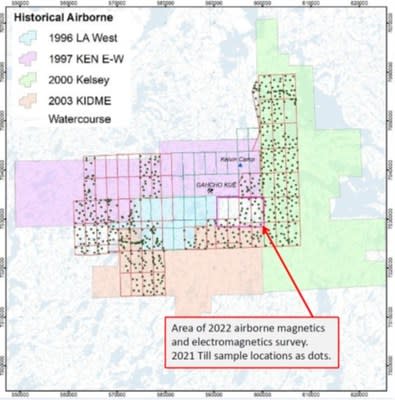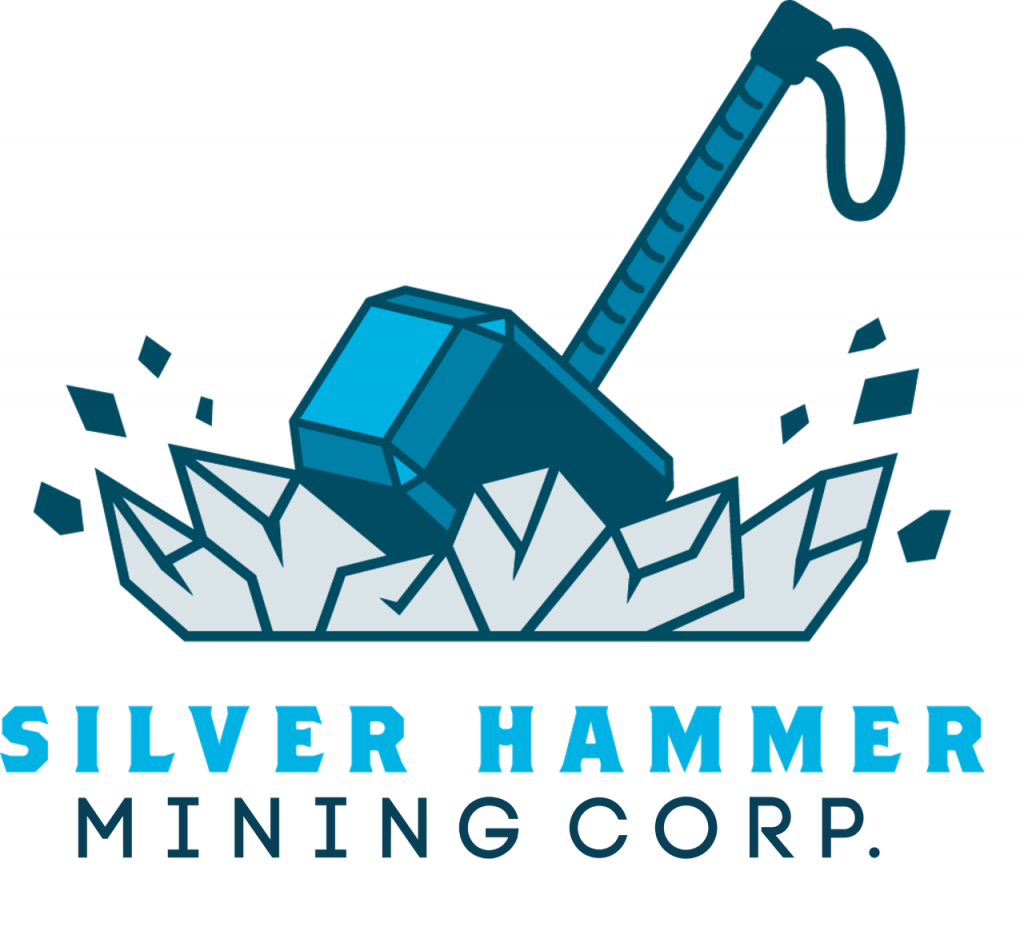TORONTO and NEW YORK, May 17, 2022 /CNW/ – Mountain Province Diamonds Inc. (“Mountain Province”, the “Company”) (TSX: MPVD) (OTC: MPVD) today announces interim exploration results for its 100%-held Kennady North Project. The Kennady North Project consists of over 107,000 hectares of claims and leases that completely surround the Gahcho Kué Diamond Mine. The 2022 exploration program is focussed on finding new kimberlites based on a detailed analysis of historical technical information including ground and airborne geophysics, kimberlite indicator minerals, and geological mapping. Approximately 3,000 of the ongoing 6,000 meter winter drill program have been completed.
Exploration Highlights for the Winter Program
- Kimberlite intersected in 16 of 20 drill holes
- 3 of 4 target areas have returned Kimberlite Intersections
- Winter geophysics completed
Mark Wall, the Company’s President and Chief Executive Officer, commented:
“We began 2022 with a plan to launch an aggressive winter exploration campaign over Kennady North, and we have achieved that plan. We have discovered kimberlite in three of four targets tested to date, and completed all of our scheduled airborne and ground geophysics. In the final weeks of our winter program, we will continue to drill-test as many priority anomalies as feasible with the intent to discover more kimberlite and add value to the Kennady North Project. As a pure Canadian diamond producer and explorer, we see this as an important time to aggressively explore for new Canadian diamond production”
Of the sixteen targets identified four have been tested by drilling so far. Drilling will continue through the rest of the winter 2022 program which is expected to culminate at the end of May. Summer exploration will start in Q3 with emphasis on follow-up sampling of indicator mineral results generated from the 2021 till sampling program, which are expected to be complete by the end of Q3. A review of all winter 2022 ground geophysical data continues through Q2 with the intent to drill areas of interest (“AOI”) with land-based anomalies in the summer program.
To date, 2,935 meters from 20 drillholes have been collected from the North Anomaly, South Anomaly, KS Anomaly and G6 Anomaly. These anomalies were defined using ARRT (a high-resolution ground resistivity system developed by Aurora Geoscience Ltd., Yellowknife), and by ground gravity. Both systems recognize the physical contrast between competent country rock and country rock adjacent to kimberlite that is broken and altered from emplacement of the kimberlite. Locations for these anomalies relative to the Kelvin and Faraday kimberlites are shown in the first set of images.


Seven drillholes completed at the North Anomaly have identified depth-extensive zones of highly altered country rock intermixed with intersects of hypabyssal kimberlite (‘HK’) ranging from 0.03 to 6.93 meters in thickness (average thickness 1.54m). Suspected volcaniclastic kimberlite (‘VK’) has been intersected in three drillholes and ranges from 0.16 to 2.13 meters in thickness (average 0.95m), with 3D modeling of the drilling indicating lateral continuity for the VK. For Kelvin and Faraday kimberlites at Kennady North, VK comprises the greatest volume and its presence in the exploration drilling is considered a good indication for volume potential at the North Anomaly.
At the South Anomaly all five drillholes have HK present with thicknesses ranging from 0.68 to 6.96 meters (average 3.23m). Country rock breccia consisting of highly comminuted gneiss mixed with kimberlite has also been observed, and is indicative of volume potential for the South Anomaly.
Four of six drillholes at the KS anomaly intersected HK kimberlite ranging from 0.22 to 1.49 meters in thickness. The present interpretation for the KS anomaly is that the system is lacking the kimberlitic fluids necessary to break up country rock and provide volume for VK to develop. A table of drill results for the North, South and KS Anomaly is provided below.
| Drill Hole | Azimuth2 | Inclination2 | Kimberlite Intersect1,2 (m) | End of Hole2(m) | |||
| From | To | Length1 | |||||
| North Anomaly | |||||||
| KDI-22-008 | 128.5 | -71.2 | 75.86 | 81.48 | 5.62 | 121.0 | |
| KDI-22-010 | 135.8 | -49.4 | 83.27 | 86.59 | 3.32 | 127.4 | |
| KDI-22-012 | 47.9 | -46.1 | 107.05 | 113.98 | 6.93 | 150.0 | |
| KDI-22-013 | 49.4 | -60.7 | 81.56 | 81.75 | 0.19 | 121.0 | |
| plus | 82.61 | 82.98 | 0.37 | ||||
| plus | 83.68 | 83.88 | 0.20 | ||||
| plus | 85.07 | 85.45 | 0.38 | ||||
| plus | 86.10 | 86.13 | 0.03 | ||||
| plus | 86.30 | 86.52 | 0.22 | ||||
| plus | 87.72 | 88.75 | 1.03 | ||||
| KDI-22-015 | 45.0 | -52.5 | 76.76 | 76.90 | 0.14 | ||
| plus | 77.66 | 78.60 | 0.94 | ||||
| plus | 80.73 | 81.10 | 0.37 | ||||
| plus | 83.90 | 87.00 | 3.10 | ||||
| KDI-22-016 | 45.0 | -62.0 | 69.50 | 72.40 | 2.90 | ||
| plus | 73.15 | 73.70 | 0.55 | ||||
| KDI-22-019 | 223.7 | -52.4 | 76.60 | 76.76 | 0.16 | ||
| plus | 77.13 | 78.83 | 1.70 | ||||
| South Anomaly | |||||||
| KDI-22-001 | 307.4 | -46.1 | 109.00 | 113.13 | 4.13 | 163.0 | |
| KDI-22-002 | 294.3 | -65.0 | 84.19 | 90.06 | 5.87 | 114.7 | |
| KDI-22-003 | 48.6 | -45.5 | 115.02 | 121.98 | 6.96 | 142.0 | |
| KDI-22-004 | 46.2 | -69.4 | 98.57 | 99.25 | 0.68 | 139.0 | |
| KDI-22-007 | 182.0 | -89.0 | 66.03 | 68.42 | 2.39 | 121.0 | |
| plus | 79.97 | 81.45 | 1.48 | ||||
| plus | 85.48 | 86.57 | 1.09 | ||||
| KS Anomaly | |||||||
| KDI-22-005 | 35.1 | -46.1 | 217.08 | 218.57 | 1.49 | 163.0 | |
| KDI-22-006 | 31.3 | -54.7 | — | — | — | 114.7 | |
| KDI-22-009 | 26.0 | -67.7 | 63.51 | 63.76 | 0.25 | 93.2 | |
| KDI-22-011 | 24.9 | -52.5 | — | — | — | 152.0 | |
| KDI-22-018 | 27.0 | -50.0 | 35.50 | 35.65 | 0.15 | 160.0 | |
| plus | 37.00 | 37.25 | 0.25 | ||||
| plus | 40.20 | 40.50 | 0.30 | ||||
| plus | 46.46 | 47.71 | 1.25 | ||||
| plus | 65.14 | 66.00 | 0.86 | ||||
| 1Intersects are not true thicknesses. 2Initial measurements from field logs may change with further drillhole surveying and logging. |
The target AOI were selected from recently-compiled studies of glacial geology and kimberlite indicator mineral (KIM) dispersions over the project area. Additional target AOI were selected after a review of historical geophysical data for Kennady North. These datasets were reviewed during several in-house workshops held in late 2021 and early 2022, with final ranking of sixteen AOI completed in a joint workshop held with De Beers in February 2022. The sixteen AOI were scheduled for ARRT and ground gravity surveys during the winter program, with a total of 188.8 line-km of ARRT and 3,139 gravity stations completed over the targets. A map image of the AOI that received ground geophysics for drill-targeting is shown in the third image.

Drilling has started at the G6 anomaly, situated on the winter spur road to Gahcho Kué Mine. The G6 anomaly is the result of a 1997 DIGHEM airborne survey that delineated the Kelvin, Faraday and Gahcho Kué kimberlites. Recent drilling over follow-up coincident ARRT and ground gravity anomalies encountered no kimberlite. Assessment of the drill data is underway.
In addition to the ground geophysical surveys, a small airborne magnetic/electromagnetic survey was conducted over an unsurveyed area located one kilometer southeast of Gahcho Kué. A total of 1,291 line-km of data were collected over the area.
In 2021 over 600 till samples were collected over the project area, including the recently staked Kennady East claims. Preliminary results for 47 samples confirm the presence of pyrope, chromite and picroilmenite in esker samples from the southern portion of the Kennady East claims. The distribution of 2021 till samples and outline of the 2022 airborne geophysics program are shown in the fourth and final image.

About the Company
Mountain Province Diamonds is a 49% participant with De Beers Canada in the Gahcho Kué diamond mine located in Canada’s Northwest Territories. The Gahcho Kué Joint Venture property consists of several kimberlites that are actively being mined, developed, and explored for future development. The Company also controls 106,202 hectares of highly prospective mineral claims and leases that surround the Gahcho Kué Joint Venture property that include an indicated mineral resource for the Kelvin kimberlite and inferred mineral resources for the Faraday kimberlites.
For further information on Mountain Province Diamonds and to receive news releases by email, visit the Company’s website at www.mountainprovince.com.
Qualified Person
The disclosure in this news release of scientific and technical information regarding Mountain Province’s mineral properties has been reviewed and approved by Matthew MacPhail, P.Eng., MBA, and Tom E. McCandless, Ph.D., P.Geo., both employees of Mountain Province Diamonds and Qualified Persons as defined by National Instrument 43-101 Standards of Disclosure for Mineral Projects.
Caution Regarding Forward Looking Information
This news release contains certain “forward-looking statements” and “forward-looking information” under applicable Canadian and United States securities laws concerning the business, operations and financial performance and condition of Mountain Province Diamonds Inc. Forward-looking statements and forward-looking information include, but are not limited to, statements with respect to operational hazards, including possible disruption due to pandemic such as COVID-19, its impact on travel, self-isolation protocols and business and operations, estimated production and mine life of the project of Mountain Province; the realization of mineral reserve estimates; the timing and amount of estimated future production; costs of production; the future price of diamonds; the estimation of mineral reserves and resources; the ability to manage debt; capital expenditures; the ability to obtain permits for operations; liquidity; tax rates; and currency exchange rate fluctuations. Except for statements of historical fact relating to Mountain Province, certain information contained herein constitutes forward-looking statements. Forward-looking statements are frequently characterized by words such as “anticipates,” “may,” “can,” “plans,” “believes,” “estimates,” “expects,” “projects,” “targets,” “intends,” “likely,” “will,” “should,” “to be”, “potential” and other similar words, or statements that certain events or conditions “may”, “should” or “will” occur. Forward-looking statements are based on the opinions and estimates of management at the date the statements are made, and are based on a number of assumptions and subject to a variety of risks and uncertainties and other factors that could cause actual events or results to differ materially from those projected in the forward-looking statements. Many of these assumptions are based on factors and events that are not within the control of Mountain Province and there is no assurance they will prove to be correct.
Factors that could cause actual results to vary materially from results anticipated by such forward-looking statements include the development of operation hazards which could arise in relation to COVID-19, including, but not limited to protocols which may be adopted to reduce the spread of COVID-19 and any impact of such protocols on Mountain Province’s business and operations, variations in ore grade or recovery rates, changes in market conditions, changes in project parametres, mine sequencing; production rates; cash flow; risks relating to the availability and timeliness of permitting and governmental approvals; supply of, and demand for, diamonds; fluctuating commodity prices and currency exchange rates, the possibility of project cost overruns or unanticipated costs and expenses, labour disputes and other risks of the mining industry, failure of plant, equipment or processes to operate as anticipated.
These factors are discussed in greater detail in Mountain Province’s most recent Annual Information Form and in the most recent MD&A filed on SEDAR, which also provide additional general assumptions in connection with these statements. Mountain Province cautions that the foregoing list of important factors is not exhaustive. Investors and others who base themselves on forward-looking statements should carefully consider the above factors as well as the uncertainties they represent and the risk they entail. Mountain Province believes that the expectations reflected in those forward-looking statements are reasonable, but no assurance can be given that these expectations will prove to be correct and such forward-looking statements included in this news release should not be unduly relied upon. These statements speak only as of the date of this news release.
Although Mountain Province has attempted to identify important factors that could cause actual actions, events or results to differ materially from those described in forward-looking statements, there may be other factors that cause actions, events or results not to be anticipated, estimated or intended. There can be no assurance that forward-looking statements will prove to be accurate, as actual results and future events could differ materially from those anticipated in such statements. Mountain Province undertakes no obligation to update forward-looking statements if circumstances or management’s estimates or opinions should change except as required by applicable securities laws. The reader is cautioned not to place undue reliance on forward-looking statements. Statements concerning mineral reserve and resource estimates may also be deemed to constitute forward-looking statements to the extent they involve estimates of the mineralization that will be encountered as the property is developed.
Further, Mountain Province may make changes to its business plans that could affect its results. The principal assets of Mountain Province are administered pursuant to a joint venture under which Mountain Province is not the operator. Mountain Province is exposed to actions taken or omissions made by the operator within its prerogative and/or determinations made by the joint venture under its terms. Such actions or omissions may impact the future performance of Mountain Province. Under its current note and revolving credit facilities Mountain Province is subject to certain limitations on its ability to pay dividends on common stock. The declaration of dividends is at the discretion of Mountain Province’s Board of Directors, subject to the limitations under the Company’s debt facilities, and will depend on Mountain Province’s financial results, cash requirements, future prospects, and other factors deemed relevant by the Board











